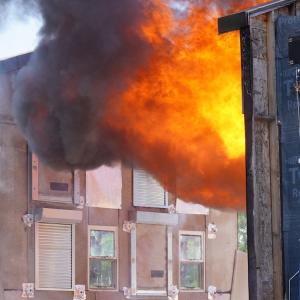
FSRI Completes Experiments to Study Window Frame Failure and the Effectiveness of Window Protection Methods
The Fire Safety Research Institute (FSRI), part of UL Research Institutes, completed experiments this fall to study window failure during prolonged exposures to a post-flashover compartment fire. Building off window experiments completed in the fall of 2022, the latest tests were conducted outdoors during two rounds at the Delaware County Emergency Services Training Center (ESTC) facility in Sharon Hill, PA, as part of the Heat Transfer from Structure Fires research project.
About Window Failure Experiments
Similar to the 2022 experiments, target facades were exposed to a post-flashover fire from a source compartment with an attached facade. The source fire was left to transition through flashover to simulate fire spread from the interior to the exterior of a structure. Eight double-hung windows mounted in a facade were exposed to the fire for approximately 10 – 15 minutes post-flashover. Heat flux and temperature data were collected through carefully positioned instrumentation for each round of experiments:
- Heat flux gauges paired with thermocouples were installed at the corner of each window on the fire side of the target facade.
- Heat flux gauges paired with thermocouples were centered two inches behind the top and bottom pane assemblies of each window in the target facade.
- Four thermocouples were installed in a vertical array near the back wall of the source compartment.
The first series of experiments focused on six different types of window protection methods with a goal of understanding the effectiveness of each protection type. Four of the protection materials are commercially-available products that could be easily procured by a homeowner: 1/4 inch fiber cement board, 1/2 inch plywood, a carbon fiber heat resistant welding blanket, and a heat-deflecting foil-backed fiberglass fabric. The two additional materials included products specifically designed for protection from wildland/WUI fires: a stainless steel mesh screen intended to protect against embers and radiant heat and an intumescent material designed to protect wooden utility poles from fire. In this series, each protection method was positioned over different windows, and two windows remained unprotected to serve as a baseline. Ten experiments were conducted with separation distances of six feet, 10 feet, and 14 feet between the source compartment and target facade.

The second series of experiments studied the failure mechanisms of different window frame types when exposed to the source fire. The four window frame types included vinyl, fiberglass, wood, and aluminum. For each experiment, two of each window frame type were mounted in the target facade. The window frame experiments were repeated 10 times while varying the position of each window frame type in the target facade and using separation distances of 10 feet, 14 feet, and 18 feet between the source compartment and target facade.

“If a window fails, there is now an opening in a structure through which firebrands can enter and potentially ignite combustibles inside the structure. Even without window failure, if there is enough heat transfer through the window, combustibles within the vicinity can still potentially ignite inside the structure.”
Research Engineer
UL Research Institutes | Fire Safety Research Institute
Visual observations made during these experiments along with a detailed analysis of data collected will be presented in a future peer-reviewed publication. Findings from this project will have critical implications for establishing proper control measures and supporting code development in both urban and WUI environments.

